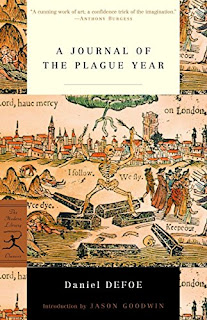Basically, the book is a fictional story of a saddle maker, who decides to remain in London during the plague of 1665. Defoe published the book in 1722, basing it on his childhood memories, statistical data, and many works that had already been published. In a very journalistic style, the saddle maker talks about what life is like being isolated and about the city when he often goes out around town, which is very life threatening. All those who can have left for the countryside. He has to stay because of his business, and he doesn't have adequate funds to leave town. He reports on conversations and stories, and on people screaming in pain, people wailing in grief from the discovery that their family members were ill or had passed away, people trying to continue to work, people escaping London to live in the forest, and so on. During his relatively short complete isolation, the saddle maker's friend, a doctor, came over, and, like everyone today, the saddle maker was so glad to talk with his friend. Importantly, I started reading a version of the book, which had been rewritten in language of today, which was very easy to read. I also read another version with language of the time, which took some getting used to reading. The whole book is just so interesting about what life was like at that time. I highly recommend it.
Now, I don't think that the book is psychogeography. He talks about London, but it seems like a newspaper reporter going out and talking about all the crazy things he sees. Here is my earlier discussion of psychogeography, which, in my opinion, doesn't include this (great) book.

No comments:
Post a Comment
Due to spammers, I am restricting comments.